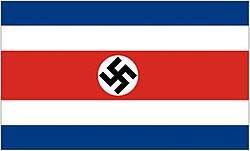Neo-Nazism in Costa Rica
Neo-Nazism in Costa Rica is a social phenomenon that emerged at the beginning of the 21st century. It usually extends between skinheads groups mostly composed of young people.

The Costa Rican neo-Nazis focus their rejection towards Jews, blacks, Asians, homosexuals, communists, feminists and, especially, Nicaraguan, Colombian, Dominican, Lebanese and other nationalities.[1]
First groups
The first group to have notoriety for the media coverage it represented was the so-called National Socialist Party of Costa Rica, whose leader named Gregorio and known by the alias "Pretoriano SS" was interviewed by the newspaper La Nación in 2003. Gregorio himself was the son of Nicaraguan migrants, although he claimed that they were "white". Other groups that have records of their existence, at least virtual, are the Costa Rican National Socialist Youth, New Social Order, Costa Rican National Socialist Ideological Resistance (which appears as the Costa Rican member in the World Union of National Socialists) and the esotericist Costa Rican Society of the Hyperborean Spear[2] attached to the esoteric hitlerism of Miguel Serrano.[3]
Neo-nazi police officer
In April 2012, it became publicly known that a Costa Rican police officer posed on social networks using Nazi symbols and carrying out the fascist salute, causing a furore among public opinion.[4] Moreover, the officer himself claimed not to be alone but that there was a full group of supporters of German Nazism among the police.[5] Although this was never determined, it was established that the person was a police officer.[6]
The young man was identified as Ronald "Murdock" Herrera and father of three daughters. Herrera was suspended almost immediately and then fired for loss of confidence, being the only person so far to be fired from the Public Force by Nazi sympathies.[7]
Subsequent reports showed that after his departure from the police, Herrera had serious difficulties in finding a job and taking care of his family, and suffered threats from anti-Fascists. It was reported that he committed suicide on April 2, 2016.[8][9]
Recent events
In 2015, the Simon Wiesenthal Center asked the Costa Rican government to shut down a store in San José that sells Nazi paraphernalia, Holocaust denial books and other products associated with Nazism.[10]
In 2018, it transpired that a series of pages of the social network Facebook of neo-Nazi inclination openly or discreetly carried out a vast campaign instigating xenophobic hatred by recycling old news or divulging Fake news to take advantage of an anti-immigrant sentiment after three homicides to tourists allegedly committed by migrants (although from one of the homicides the suspect is Costa Rican).[11] A rally against the country's migration policy was made on August 19, 2018, in which neo-Nazi and hooligans took part. Although not all participants were linked these groups and the majority of participants were peaceful, the protest turned violent and the Public Force had to intervene with a balance of 44 arrested, 36 Costa Ricans and the rest Nicaraguans.[12][13] To the neo-Nazis were confiscated different types of sharp weapons, Molotov cocktails and other items, as well as being identified with swastika flags.[14] A subsequent anti-xenophobic march and solidarity with the Nicaraguan refugees was organized a week later with more assistance. A second anti-migration demonstration but with the explicit exclusion of neo-Nazis and hooligans was carried out in September with similar assistance.[15] In 2019 Facebook pages of extreme right-wing tendencies and anti-immigration position as Deputy 58, Costa Rican Resistance and Salvation Costa Rica called an anti-government demonstration on May 1 with small attendance.[16][17]
References
- "Aparece grupo neonazi en Costa Rica". Nación. 9 November 2003. Retrieved 19 December 2018.
- "Brotes clandestinos". El Universal. 2012. Retrieved 16 July 2019.
- Introvigne, Massimo (2016). Esoteric Movements and Nationalism in Costa Rica (PDF). CESNUR. Retrieved 16 July 2019.
- Delgado, David (16 April 2012). "Fuerza Pública investiga fotos de policía en Facebook". Nacion.com. Retrieved 19 December 2018.
- Mendoza, Adrián (16 April 2012). "Peligroso movimiento se gesta en Costa Rica". CRHoy. Retrieved 25 May 2019.
- "Neonazis sí es oficial de la Fuerza Pública, confirman autoridades". El Periódico. Retrieved 19 December 2018.
- Miranda, Hulda; Rodríguez, Óscar. "Policía cesado por usar símbolos nazis recoge chatarra para vivir". Retrieved 19 December 2018.
- "Expolicía nazi se quita la vida y deja un extenso mensaje". Diario Extra. 2 April 2016. Retrieved 19 December 2018.
- Miranda, Hulda; Rodríguez, Óscar; Solano, Hugo (2 April 2016). "Expolicía despedido por ideología nazi se suicidó en su casa". Nación.com. Retrieved 19 December 2018.
- "Centro Wiesenthal insta a Costa Rica a investigar tienda «nazi» en la capital". EFE - El País. 11 September 2015. Retrieved 25 May 2019.
- Rico (18 August 2018). "44 arrested for xenophobic attacks against Nicaraguans in San José". QCosta Rica. Retrieved 2 November 2018.
- "Costa Rica: symboles nazis lors d'une manifestation anti-migrants nicaraguayens". Journal de Montreal. 19 August 2018. Retrieved 2 November 2018.
- Castillo, Bryan (18 August 2018). "'Neonazis' e integrantes de barras de fútbol participaron en agresiones a nicaragüenses". La Teja. Retrieved 25 May 2019.
- "Costa Rica: violenta protesta contra inmigración nicaragüense". DW. Retrieved 2 November 2018.
- Redaccion (26 August 2018). "Costa Rica marcha contra la xenofobia hacia los migrantes de Nicaragua que llegan al país huyendo de la crisis". BBC Mundo. Retrieved 2 November 2018.
- Chinchilla, Aarón (30 April 2019). "Ultranacionalistas costarricenses convocan marcha contra Gobierno en 1 de Mayo". El Periódico. Retrieved 24 June 2019.
- Cartín, Cristian (30 April 2019). "Llaman a concentrarse contra Carlos Alvarado". Diario Extra. Retrieved 24 June 2019.